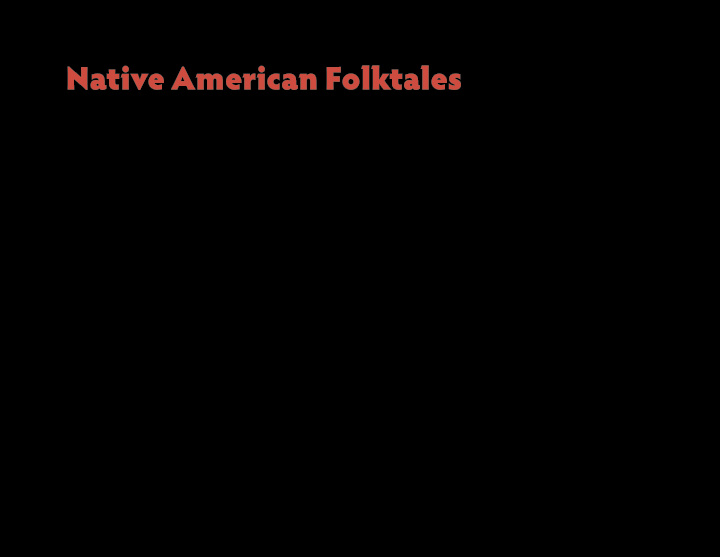



Native American Folktales 01.29.12 || English 2327: Am erican Literature I || D. Glen Sm ith, instructor
Com prehension of Folk Stories It is im portant to rem em ber these stories were never intended to be written as a perm anent cultural record. The individual tribes believed no one owned the material. • room for re-invention existed • multiple versions of one story can exist • each individual story-teller was allowed creative interpretation • collectively these stories exist as living documents • collectively these stories exist as spiritual, abstract explanations for unknowable situations 01.29.12 || English 2327: Am erican Literature I || D. Glen Sm ith, instructor 2
Navajo Trickster Folk Story The Navajo reside in the Southwestern US. This region is known as four corners with the intersection of four states: Utah, New Mexico, Arizona, Colorado. • “Coyote, Skunk, and the Prairie Dogs” serves as a strong example of a trickster folk tale. • In the version provided, it reads as a transcript of an actual performance with audience participation shown. 01.29.12 || English 2327: Am erican Literature I || D. Glen Sm ith, instructor 3
Repeating Phrases The editors of the Norton Anthology state how a repetitive phrase within the text exists as a “possible linguistic m arker” (98 ). This reaffi rms that the story-teller/ narrator was not an actual witness to the events described. • However the phrase “jiní”— which translates to mean “it is said”— confi rms the situation is based on a perceived truth. • Notice the phrase repeats frequently, mirroring the intentions of biblical texts from ancient times; in Genesis, the verbiage “—and God saw it was good” plus “and it was so” repeat frequently. • For both cultures, these repeating phrases are important for aiding in recitation, but also emphasize important lessons to provide the audience. • If an event repeats it is crucial to the development of the plot or characterization of the folk hero. 01.29.12 || English 2327: Am erican Literature I || D. Glen Sm ith, instructor 4
Coyote The opening passage shows the m ain character of Coyote displayed as the expected dog-like creature. “Ma’ii was trotting along like he’s always done” (98). • it is soon evident that he is more than the average animal • Coyote thinks of an event, the event unfolds in a cause-effect process “‘If only there could be rain in my footprints.’ And that’s what happened, it is said. ‘If only water would ooze between my toes as I walk along,’ he said. Then everything happened as he said, it is said” (99). • Later in the story the character will utilize a club in a human-like fashion, showing the multi-dimensional characterization of the hero: part human, part animal. 01.29.12 || English 2327: Am erican Literature I || D. Glen Sm ith, instructor 5
Sim ilarity to Fables On a basic level, these stories m im ic the intentions of the Ancient Greek Fables. Talking animals exist in fables as representatives of human personalities. • Many modern characterizations of animals are based on these ideas: • Lessons are taught on cultural behavior through the actions of the animals. • The natural behavior of a particular animal is also explained. • Oftentimes a cartoon-logic is mixed in to the plot for entertainment. • A specifi c moral is presented at the closing of these allegorical stories. • Usually these stories simply explain how to behave in a culture, (or how not to behave) and sometimes how to get along with fellow humans. 01.29.12 || English 2327: Am erican Literature I || D. Glen Sm ith, instructor 6
Ancient Greek Fable The Fox a nd the Goa t | | a ttributed to Aesop A Fox one day fell into a deep well and could fi nd no means of escape. A Goat, overcome with thirst, came to the same well, and seeing the Fox, inquired if the water was good. Con- cealing his sad plight under a merry guise, the Fox indulged in a lavish praise of the water, saying it was excellent beyond measure, and encouraging him to descend. The Goat, mind- ful only of his thirst, thoughtlessly jumped down, but just as he drank, the Fox informed him of the diffi culty they were both in and suggested a scheme for their common escape. “If,” said he, “you will place your forefeet upon the wall and bend your head, I will run up your back and escape, and will help you out afterwards.” The Goat readily assented and the Fox leaped upon his back. Steadying himself with the Goat’s horns, he safely reached the mouth of the well and made off as fast as he could. When the Goat upbraided him for breaking his promise, he turned around and cried out, “You foolish old fellow! If you had as many brains in your head as you have hairs in your beard, you would never have gone down before you had inspected the way up, nor have exposed yourself to dangers from which you had no means of escape.” Look before you leap. “The Fox and the Goat.” Aesop’s Fables. John R. Long, trans. Star Systems Technologies. SSTec.com . 12 May 2008. Web. 28 Dec. 2009. 01.29.12 || English 2327: Am erican Literature I || D. Glen Sm ith, instructor 7
Flaw ed Character The Navajo folk hero Coyote is shown with m ajor fl aws. He attempts to trick Skunk into a con-game situation. • Throughout the tale, Coyote makes cultural mistakes: > he competes for food > he wastes food > he begs for food • Due to his misbehavior, he loses out in the end of the tale. 01.29.12 || English 2327: Am erican Literature I || D. Glen Sm ith, instructor 8
Recommend
More recommend